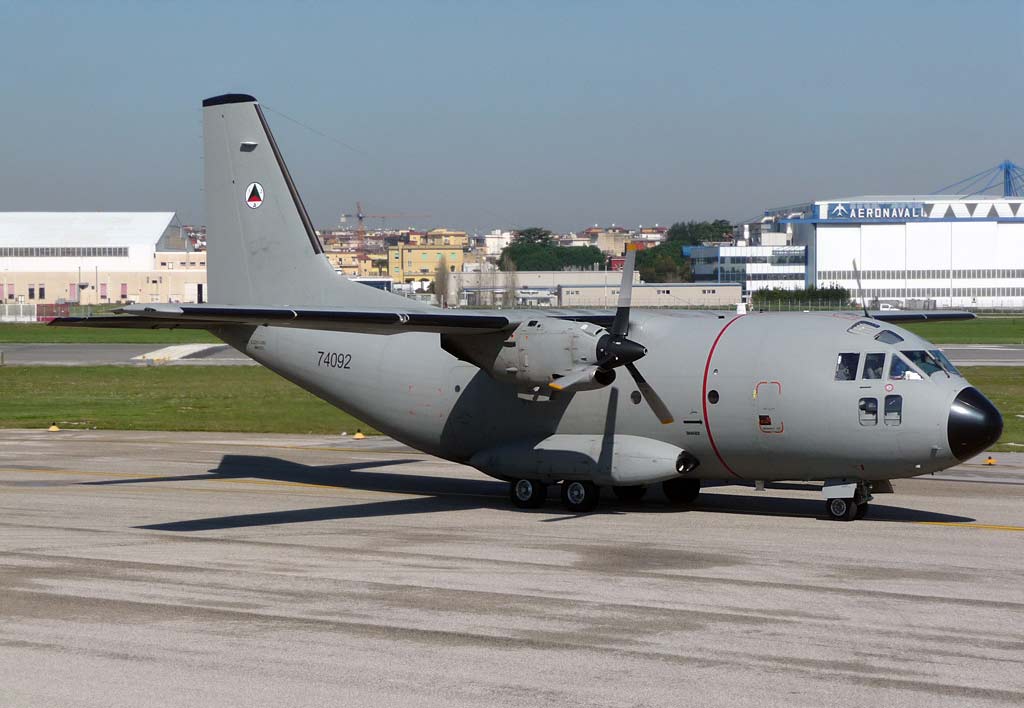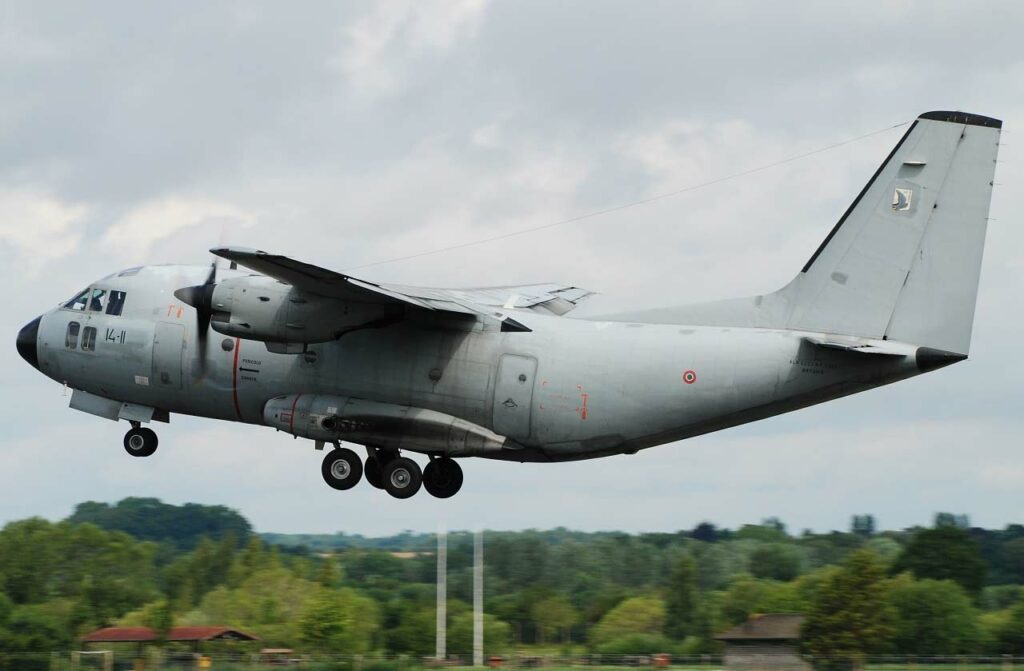Italian medium-sized, twin-turboprop tactical transport aircraft, known for STOL capabilities.
In brief
The Alenia-Aeritalia G.222 is an Italian military transport aircraft, originally developed by Aeritalia and later by Alenia Aeronautica. Featuring twin-turboprop engines, this aircraft is designed for short takeoff and landing (STOL) capabilities, allowing operation in varied and rugged conditions. Its primary use is tactical missions including troop transport, cargo delivery, and medical evacuation. With a load capacity of approximately 20,000 pounds, the G.222 can carry substantial equipment and personnel. Its versatility was enhanced by the ability to quickly convert from cargo layouts to medical or paratroop configurations, making it a flexible asset in military operations.

History of the Development of the Alenia-Aeritalia G.222
In the late 1960s, the Italian Air Force identified a need for a versatile, tactical transport aircraft capable of operating in challenging conditions, including unpaved runways. This requirement was in response to the evolving military logistics and mobility needs of the Cold War era, emphasizing rapid deployment and operational flexibility. In 1967, Aeritalia (later part of Alenia Aeronautica) was commissioned to develop such an aircraft, which led to the inception of the G.222 program.
The G.222’s design was influenced by the tactical requirements of the Italian Air Force and the NATO specifications for a medium-sized transport aircraft. This alignment was crucial as it aimed to standardize capabilities among NATO countries. The G.222 first took to the skies on July 18, 1970, demonstrating promising potential from the outset.
Although the G.222 was not assigned a specific NATO nickname—a practice common with some military aircraft—it was an integral part of NATO’s logistics and transport strategy, particularly for missions requiring high maneuverability and short runway operations. The aircraft was distinguished by its high-wing configuration, ensuring unobstructed loading and unloading operations, and its robust landing gear, which was designed to withstand the rigors of semi-prepared runways.
The development of the G.222 was not just a response to military needs but also reflected the technological ambitions of Italy during a period marked by rapid advancements in aerospace technology. The program’s initiation during the Cold War underscores the strategic importance of having a home-grown military transport capability, which not only enhanced Italy’s defense autonomy but also positioned it as a key player in the European aerospace industry.
Design of the Alenia-Aeritalia G.222
The design of the Alenia-Aeritalia G.222 focused on robustness and versatility. The aircraft features a length of 74 feet and a wingspan of 94 feet (22.7 meters and 28.7 meters, respectively). With a high-wing structure and a rear-loading ramp, the design facilitates easy loading and unloading of cargo and personnel, even in challenging environments. The G.222 is powered by two Rolls-Royce Tyne RTY-20 Mk 22 turboprop engines, each producing 3,400 horsepower, driving four-blade propellers.
The aircraft’s maximum takeoff weight is around 64,000 pounds (29,000 kilograms), and it can carry payloads up to 20,000 pounds (9,000 kilograms). It has a cruising speed of about 270 knots (500 km/h) and a range of 1,300 nautical miles (2,400 kilometers) with maximum payload, demonstrating considerable capability for medium-range missions.
One of the significant design advantages of the G.222 is its short takeoff and landing (STOL) capability, requiring runways as short as 1,800 feet (550 meters) for takeoff with a full load, which is particularly useful in forward operating bases and makeshift airstrips. This feature is complemented by the aircraft’s rugged undercarriage and high-wing configuration, which not only facilitates operation in diverse terrain but also minimizes the risk of foreign object damage during landings and takeoffs on less-than-ideal surfaces.
Despite these strengths, the G.222 had drawbacks, including relatively high maintenance demands and operational costs, primarily due to its sophisticated engineering and older technology. However, these were considered acceptable trade-offs for its advanced capabilities and operational flexibility.
Performance of the Alenia-Aeritalia G.222
The Alenia-Aeritalia G.222 showcases robust performance metrics, crucial for its role in military and humanitarian missions. The twin Rolls-Royce Tyne RTY-20 Mk 22 turboprop engines each deliver 3,400 horsepower, enabling the aircraft to achieve a maximum speed of 270 knots (500 km/h) and a service ceiling of 25,000 feet (7,620 meters). This power output allows the G.222 to excel in hot and high conditions often encountered in austere theaters of operation.
The aircraft’s range is another critical aspect, with a maximum of 1,300 nautical miles (2,400 kilometers) on a full load. This makes the G.222 adept at medium-range transport tasks, bridging the gap between tactical and strategic operations. Its payload capacity of up to 20,000 pounds (9,000 kilograms) is complemented by its capability to operate from short and semi-prepared airstrips, thanks to its STOL features.
When compared to contemporaries such as the C-130 Hercules, the G.222 does not quite match up in terms of range and payload but offers superior performance in STOL capabilities and flexibility in operating environments. This distinction made the G.222 particularly valuable in regions where infrastructure was limited or in rapid response scenarios.
Variants of the Alenia-Aeritalia G.222
The G.222 program spawned several variants, catering to different operational needs. The initial production model was followed by the G.222TCM, a variant specifically enhanced for tactical communications missions. Another notable version was the G.222VS, equipped with advanced electronic surveillance capabilities for intelligence missions.
Each variant maintained the core capabilities of the base model but was adapted with specialized equipment and configurations to meet specific requirements. These adaptations included modifications in avionics, cargo handling systems, and, in some cases, defensive measures to enhance survivability in hostile environments.

Military Use and Combat of the Alenia-Aeritalia G.222
The military and combat use of the G.222 has been extensive, serving primarily with the Italian Air Force and exported to various nations. Its operational roles have included tactical transport, electronic warfare, and humanitarian relief, showcasing its adaptability. The aircraft’s rear ramp and door configuration facilitated rapid deployment of troops and equipment, crucial in combat and crisis situations.
In conflicts, the G.222 has been used for troop movements, logistical support, and casualty evacuation. It participated in several notable operations, including peacekeeping missions in the Balkans during the 1990s, where its capabilities were integral to NATO’s operational effectiveness. The aircraft’s performance in these demanding conditions confirmed its reliability and robustness, essential for the varied and unpredictable nature of military operations.
The G.222 has been phased out by some operators and replaced with more modern aircraft like the C-27J Spartan, which offers enhanced performance, greater payload capacity, and newer technology. However, its legacy continues in the capabilities and design influences evident in its successors.
The Alenia-Aeritalia G.222 was a significant development in military transport, notable for its flexibility, robust design, and STOL capabilities. While it has been surpassed by newer technology, its impact on tactical air transport and the lessons drawn from its operational history continue to influence modern aerospace design and military strategy.
Back to Transport planes.